Physical-Guided Transfer Deep Neural Network for High-Resolution AOD Retrieval
Highlights
- A physical-guided transfer deep neural network (PT-DNN) model is proposed for retrieving AOD at 30 m spatial resolution.
- The model employs a two-stage training strategy that combines radiative transfer simulations with ground-based measurements.
- The model achieves higher accuracy than the conventional data-driven model and the existing AOD product.
- It facilitates detailed characterization of fine-scale aerosol pollution patterns in complex urban and peri-urban environments.
Abstract
1. Introduction
2. Data
2.1. AERONET Data
2.2. Landsat 8 OLI Data
2.3. Auxiliary Data
3. Methods
3.1. Physical Prior Modeling
3.2. Task Adaptation Modeling
3.3. Model Structure
3.4. Model Training
4. Results
4.1. Model Validation
4.2. Accuracy Comparison
5. Discussion
5.1. Spatial Heterogeneity of the Predicted AOD
5.2. Robustness of the Validation Strategy
5.3. Other Discussions
6. Conclusions
Author Contributions
Funding
Data Availability Statement
Acknowledgments
Conflicts of Interest
References
- Arfin, T.; Pillai, A.M.; Mathew, N.; Tirpude, A.; Bang, R.; Mondal, P. An overview of atmospheric aerosol and their effects on human health. Environ. Sci. Pollut. Res. 2023, 30, 125347–125369. [Google Scholar] [CrossRef]
- Li, J.; Carlson, B.E.; Yung, Y.L.; Lv, D.; Hansen, J.; Penner, J.E.; Liao, H.; Ramaswamy, V.; Kahn, R.A.; Zhang, P. Scattering and absorbing aerosols in the climate system. Nat. Rev. Earth Environ. 2022, 3, 363–379. [Google Scholar] [CrossRef]
- Che, H.; Xia, X.; Zhao, H.; Li, L.; Gui, K.; Zheng, Y.; Song, J.; Qi, B.; Zhu, J.; Miao, Y. Aerosol optical and radiative properties and their environmental effects in China: A review. Earth-Sci. Rev. 2024, 248, 104634. [Google Scholar] [CrossRef]
- Wei, J.; Wang, J.; Li, Z.; Kondragunta, S.; Anenberg, S.; Wang, Y.; Zhang, H.; Diner, D.; Hand, J.; Lyapustin, A. Long-term mortality burden trends attributed to black carbon and PM2· 5 from wildfire emissions across the continental USA from 2000 to 2020: A deep learning modelling study. Lancet Planet. Health 2023, 7, e963–e975. [Google Scholar] [CrossRef]
- Tian, Y.; Ma, Y.; Wu, J.; Wu, Y.; Wu, T.; Hu, Y.; Wei, J. Ambient PM2. 5 chemical composition and cardiovascular disease hospitalizations in China. Environ. Sci. Technol. 2024, 58, 16327–16335. [Google Scholar] [CrossRef] [PubMed]
- Pahlevan, N.; Mangin, A.; Balasubramanian, S.V.; Smith, B.; Alikas, K.; Arai, K.; Barbosa, C.; Bélanger, S.; Binding, C.; Bresciani, M. ACIX-Aqua: A global assessment of atmospheric correction methods for Landsat-8 and Sentinel-2 over lakes, rivers, and coastal waters. Remote Sens. Environ. 2021, 258, 112366. [Google Scholar] [CrossRef]
- Ma, Z.; Dey, S.; Christopher, S.; Liu, R.; Bi, J.; Balyan, P.; Liu, Y. A review of statistical methods used for developing large-scale and long-term PM2. 5 models from satellite data. Remote Sens. Environ. 2022, 269, 112827. [Google Scholar] [CrossRef]
- Zhang, T.; Zhang, W.; Yang, R.; Liu, Y.; Jafari, M. CO2 capture and storage monitoring based on remote sensing techniques: A review. J. Clean. Prod. 2021, 281, 124409. [Google Scholar] [CrossRef]
- Dagan, G.; Yeheskel, N.; Williams, A.I. Radiative forcing from aerosol–cloud interactions enhanced by large-scale circulation adjustments. Nat. Geosci. 2023, 16, 1092–1098. [Google Scholar] [CrossRef]
- Wei, X.; Bai, K.; Chang, N.-B.; Gao, W. Multi-source hierarchical data fusion for high-resolution AOD mapping in a forest fire event. Int. J. Appl. Earth Obs. Geoinf. 2021, 102, 102366. [Google Scholar] [CrossRef]
- Hauser, A.; Oesch, D.; Foppa, N.; Wunderle, S. NOAA AVHRR derived aerosol optical depth over land. J. Geophys. Res. Atmos. 2005, 110. [Google Scholar] [CrossRef]
- Levy, R.C.; Mattoo, S.; Munchak, L.; Remer, L.; Sayer, A.; Patadia, F.; Hsu, N. The Collection 6 MODIS aerosol products over land and ocean. Atmos. Meas. Tech. 2013, 6, 2989–3034. [Google Scholar] [CrossRef]
- Kahn, R.A.; Nelson, D.L.; Garay, M.J.; Levy, R.C.; Bull, M.A.; Diner, D.J.; Martonchik, J.V.; Paradise, S.R.; Hansen, E.G.; Remer, L.A. MISR aerosol product attributes and statistical comparisons with MODIS. IEEE Trans. Geosci. Remote Sens. 2009, 47, 4095–4114. [Google Scholar] [CrossRef]
- Jackson, J.M.; Liu, H.; Laszlo, I.; Kondragunta, S.; Remer, L.A.; Huang, J.; Huang, H.C. Suomi-NPP VIIRS aerosol algorithms and data products. J. Geophys. Res. Atmos. 2013, 118, 12673–12689. [Google Scholar] [CrossRef]
- Yang, L.; Ji, W.; Pei, X.; Si, Y.; Liu, H.; Chen, S.; Zhang, C.; Cheng, X.; Lu, X.; Wang, H. Global evaluation of Fengyun-3 MERSI dark target aerosol retrievals over land. Int. J. Digit. Earth 2024, 17, 1–24. [Google Scholar] [CrossRef]
- Pei, X.; Yang, L.; Ji, W.; Chen, S.; Cheng, X.; Lu, X.; Wang, H. Applying the Dark Target Aerosol Algorithm to MERSI-II: Retrieval and Validation of Aerosol Optical Depth over the Ocean. Adv. Atmos. Sci. 2024, 41, 2446–2463. [Google Scholar] [CrossRef]
- Gayen, B.K.; Acharya, P.; Dutta, D.; Sreekesh, S. Estimation of high-resolution aerosol optical depth (AOD) from Landsat and Sentinel images using SEMARA model over selected locations in South Asia. Atmos. Res. 2024, 298, 107141. [Google Scholar] [CrossRef]
- Lin, H.; Li, S.; Xing, J.; He, T.; Yang, J.; Wang, Q. High resolution aerosol optical depth retrieval over urban areas from Landsat-8 OLI images. Atmos. Environ. 2021, 261, 118591. [Google Scholar] [CrossRef]
- Dong, J.; Zhang, T.; Wang, L.; Li, Z.; Wong, M.S.; Bilal, M.; Zhu, Z.; Mao, F.; Xia, X.; Han, G. First retrieval of daily 160 m aerosol optical depth over urban areas using Gaofen-1/6 synergistic observations: Algorithm development and validation. ISPRS J. Photogramm. Remote Sens. 2024, 211, 372–391. [Google Scholar] [CrossRef]
- Levy, R.C.; Remer, L.A.; Mattoo, S.; Vermote, E.F.; Kaufman, Y.J. Second-generation operational algorithm: Retrieval of aerosol properties over land from inversion of Moderate Resolution Imaging Spectroradiometer spectral reflectance. J. Geophys. Res. Atmos. 2007, 112. [Google Scholar] [CrossRef]
- Hsu, N.; Jeong, M.J.; Bettenhausen, C.; Sayer, A.M.; Hansell, R.; Seftor, C.; Huang, J.; Tsay, S.C. Enhanced Deep Blue aerosol retrieval algorithm: The second generation. J. Geophys. Res. Atmos. 2013, 118, 9296–9315. [Google Scholar] [CrossRef]
- Martonchik, J.V.; Kahn, R.A.; Diner, D.J. Retrieval of aerosol properties over land using MISR observations. In Satellite Aerosol Remote Sensing over Land; Springer: Berlin/Heidelberg, Germany, 2009; pp. 267–293. [Google Scholar]
- Taskinen, H.; Väisänen, A.; Hatakka, L.; Virtanen, T.H.; Lähivaara, T.; Arola, A.; Kolehmainen, V.; Lipponen, A. High-Resolution Post-Process Corrected Satellite AOD. Geophys. Res. Lett. 2022, 49, e2022GL099733. [Google Scholar] [CrossRef]
- Lipponen, A.; Reinvall, J.; Väisänen, A.; Taskinen, H.; Lähivaara, T.; Sogacheva, L.; Kolmonen, P.; Lehtinen, K.; Arola, A.; Kolehmainen, V. Deep-learning-based post-process correction of the aerosol parameters in the high-resolution Sentinel-3 Level-2 Synergy product. Atmos. Meas. Tech. 2022, 15, 895–914. [Google Scholar] [CrossRef]
- Remer, L.A.; Levy, R.C.; Martins, J.V. Opinion: Aerosol remote sensing over the next 20 years. Atmos. Chem. Phys. 2024, 24, 2113–2127. [Google Scholar] [CrossRef]
- Chen, X.; de Leeuw, G.; Arola, A.; Liu, S.; Liu, Y.; Li, Z.; Zhang, K. Joint retrieval of the aerosol fine mode fraction and optical depth using MODIS spectral reflectance over northern and eastern China: Artificial neural network method. Remote Sens. Environ. 2020, 249, 112006. [Google Scholar] [CrossRef]
- She, L.; Zhang, H.K.; Bu, Z.; Shi, Y.; Yang, L.; Zhao, J. A deep-neural-network-based aerosol optical depth (AOD) retrieval from Landsat-8 Top of Atmosphere Data. Remote Sens. 2022, 14, 1411. [Google Scholar] [CrossRef]
- Zhang, Z.; Li, J.; Che, H.; Dong, Y.; Dubovik, O.; Eck, T.; Gupta, P.; Holben, B.; Kim, J.; Lind, E. Long-term trends in aerosol properties derived from AERONET measurements. Atmos. Chem. Phys. 2025, 25, 4617–4637. [Google Scholar] [CrossRef]
- Liang, L.; Daniels, J.; Biancardi, M.; Zhou, Y. Reconstructing aerosol optical depth using spatiotemporal Long Short-Term Memory convolutional autoencoder. Sci. Data 2023, 10, 842. [Google Scholar] [CrossRef]
- Shi, C.; Hashimoto, M.; Shiomi, K.; Nakajima, T. Development of an algorithm to retrieve aerosol optical properties over water using an artificial neural network radiative transfer scheme: First result from GOSAT-2/CAI-2. IEEE Trans. Geosci. Remote Sens. 2020, 59, 9861–9872. [Google Scholar] [CrossRef]
- Jia, C.; Sun, L.; Chen, Y.; Liu, Q.; Yu, H.; Zhang, W. Satellite aerosol retrieval using scene simulation and deep belief network. IEEE Trans. Geosci. Remote Sens. 2021, 60, 4104516. [Google Scholar] [CrossRef]
- Tao, M.; Chen, J.; Xu, X.; Man, W.; Xu, L.; Wang, L.; Wang, Y.; Wang, J.; Fan, M.; Shahzad, M.I. A robust and flexible satellite aerosol retrieval algorithm for multi-angle polarimetric measurements with physics-informed deep learning method. Remote Sens. Environ. 2023, 297, 113763. [Google Scholar] [CrossRef]
- Man, W.; Tao, M.; Xu, L.; Xu, X.; Jiang, J.; Wang, J.; Wang, L.; Wang, Y.; Fan, M.; Chen, L. Improving aerosol retrieval from MISR with a physics-informed deep learning method. IEEE Trans. Geosci. Remote Sens. 2024, 62, 4102911. [Google Scholar] [CrossRef]
- Holben, B.N.; Eck, T.F.; Slutsker, I.a.; Tanre, D.; Buis, J.; Setzer, A.; Vermote, E.; Reagan, J.A.; Kaufman, Y.; Nakajima, T. AERONET—A federated instrument network and data archive for aerosol characterization. Remote Sens. Environ. 1998, 66, 1–16. [Google Scholar] [CrossRef]
- Chen, A.; Zhao, C.; Shen, L.; Fan, T. Influence of aerosol properties and surface albedo on radiative forcing efficiency of key aerosol types using global AERONET data. Atmos. Res. 2023, 282, 106519. [Google Scholar] [CrossRef]
- Wei, J.; Wang, Z.; Li, Z.; Li, Z.; Pang, S.; Xi, X.; Cribb, M.; Sun, L. Global aerosol retrieval over land from Landsat imagery integrating Transformer and Google Earth Engine. Remote Sens. Environ. 2024, 315, 114404. [Google Scholar] [CrossRef]
- Skakun, S.; Vermote, E.F.; Roger, J.-C.; Justice, C.O.; Masek, J.G. Validation of the LaSRC cloud detection algorithm for Landsat 8 images. IEEE J. Sel. Top. Appl. Earth Obs. Remote Sens. 2019, 12, 2439–2446. [Google Scholar] [CrossRef]
- Zhang, X.; Zhao, T.; Xu, H.; Liu, W.; Wang, J.; Chen, X.; Liu, L. GLC_FCS30D: The first global 30-m land-cover dynamic monitoring product with a fine classification system from 1985 to 2022 using dense time-series Landsat imagery and continuous change-detection method. Earth Syst. Sci. Data Discuss. 2023, 2023, 1–32. [Google Scholar] [CrossRef]
- Rodriguez, E.; Morris, C.S.; Belz, J.E. A global assessment of the SRTM performance. Photogramm. Eng. Remote Sens. 2006, 72, 249–260. [Google Scholar] [CrossRef]
- Kotchenova, S.Y.; Vermote, E.F.; Levy, R.; Lyapustin, A. Radiative transfer codes for atmospheric correction and aerosol retrieval: Intercomparison study. Appl. Opt. 2008, 47, 2215–2226. [Google Scholar] [CrossRef]
- Kim, M.; Kim, J.; Wong, M.S.; Yoon, J.; Lee, J.; Wu, D.; Chan, P.; Nichol, J.E.; Chung, C.-Y.; Ou, M.-L. Improvement of aerosol optical depth retrieval over Hong Kong from a geostationary meteorological satellite using critical reflectance with background optical depth correction. Remote Sens. Environ. 2014, 142, 176–187. [Google Scholar] [CrossRef]
- Wei, J.; Huang, B.; Sun, L.; Zhang, Z.; Wang, L.; Bilal, M. A simple and universal aerosol retrieval algorithm for Landsat series images over complex surfaces. J. Geophys. Res. Atmos. 2017, 122, 13338–13355. [Google Scholar] [CrossRef]
- Yang, Y.; Yang, K.; Chen, Y. Aerosol retrieval algorithm for Sentinel-2 images over complex urban areas. IEEE Trans. Geosci. Remote Sens. 2022, 60, 4107509. [Google Scholar] [CrossRef]
- Jia, C.; Sun, L.; Chen, Y.; Wang, W.; Wang, Y. Inversion of aerosol optical depth for Landsat 8 OLI data using deep belief network. Natl. Remote Sens. Bull. 2020, 24, 1180–1192. [Google Scholar]
- He, F.; Liu, T.; Tao, D. Why resnet works? residuals generalize. IEEE Trans. Neural Netw. Learn. Syst. 2020, 31, 5349–5362. [Google Scholar] [CrossRef]
- Ghosh, A.; Kumar, H.; Sastry, P.S. Robust loss functions under label noise for deep neural networks. In Proceedings of the AAAI Conference on Artificial Intelligence, San Francisco, CA, USA, 4–9 February 2017. [Google Scholar]
- She, L.; Zhang, H.K.; Li, Z.; de Leeuw, G.; Huang, B. Himawari-8 aerosol optical depth (AOD) retrieval using a deep neural network trained using AERONET observations. Remote Sens. 2020, 12, 4125. [Google Scholar] [CrossRef]
- Lyapustin, A.; Wang, Y.; Korkin, S.; Huang, D. MODIS collection 6 MAIAC algorithm. Atmos. Meas. Tech. 2018, 11, 5741–5765. [Google Scholar] [CrossRef]
- Lyapustin, A.; Wang, Y.; Laszlo, I.; Kahn, R.; Korkin, S.; Remer, L.; Levy, R.; Reid, J. Multiangle implementation of atmospheric correction (MAIAC): 2. Aerosol algorithm. J. Geophys. Res. Atmos. 2011, 116. [Google Scholar] [CrossRef]
- Si, Y.; Chen, L.; Wang, Y.; Xu, N.; Zhang, X.; Yang, L.; Hu, X.; Shi, S. An Improved Aerosol Retrieval Algorithm Based on Nonlinear Surface Model From FY-3D/MERSI-II Remote Sensing Data. IEEE Trans. Geosci. Remote Sens. 2024, 62, 4103017. [Google Scholar] [CrossRef]
- Zhao, D.; Feng, L.; Sun, K. Development of a practical atmospheric correction algorithm for inland and nearshore coastal waters. IEEE Trans. Geosci. Remote Sens. 2021, 60, 5402515. [Google Scholar] [CrossRef]
- Yang, Y.; Chen, Y.; Yang, K.; Cermak, J.; Chen, Y. High-resolution aerosol retrieval over urban areas using sentinel-2 data. Atmos. Res. 2021, 264, 105829. [Google Scholar] [CrossRef]


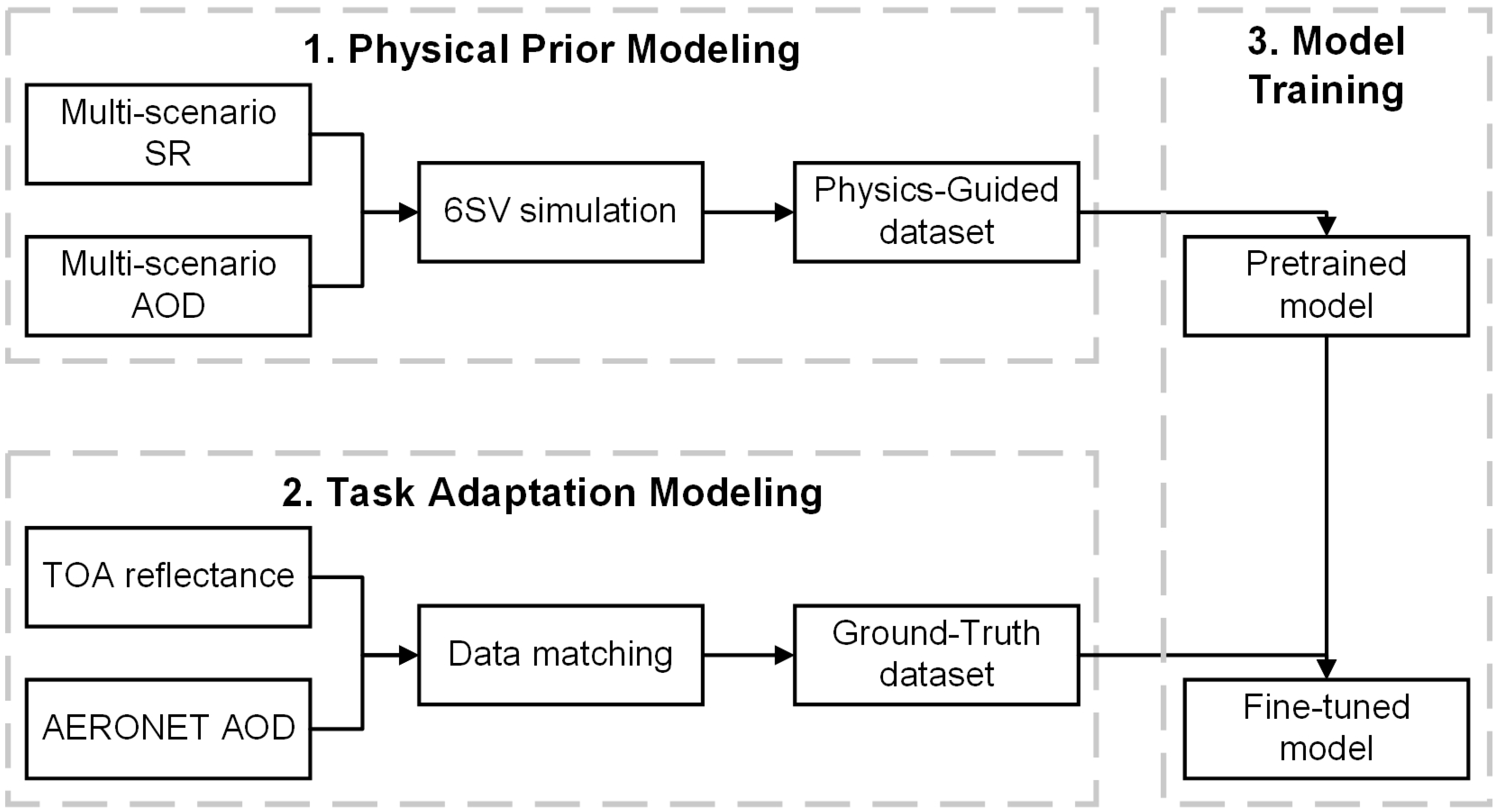

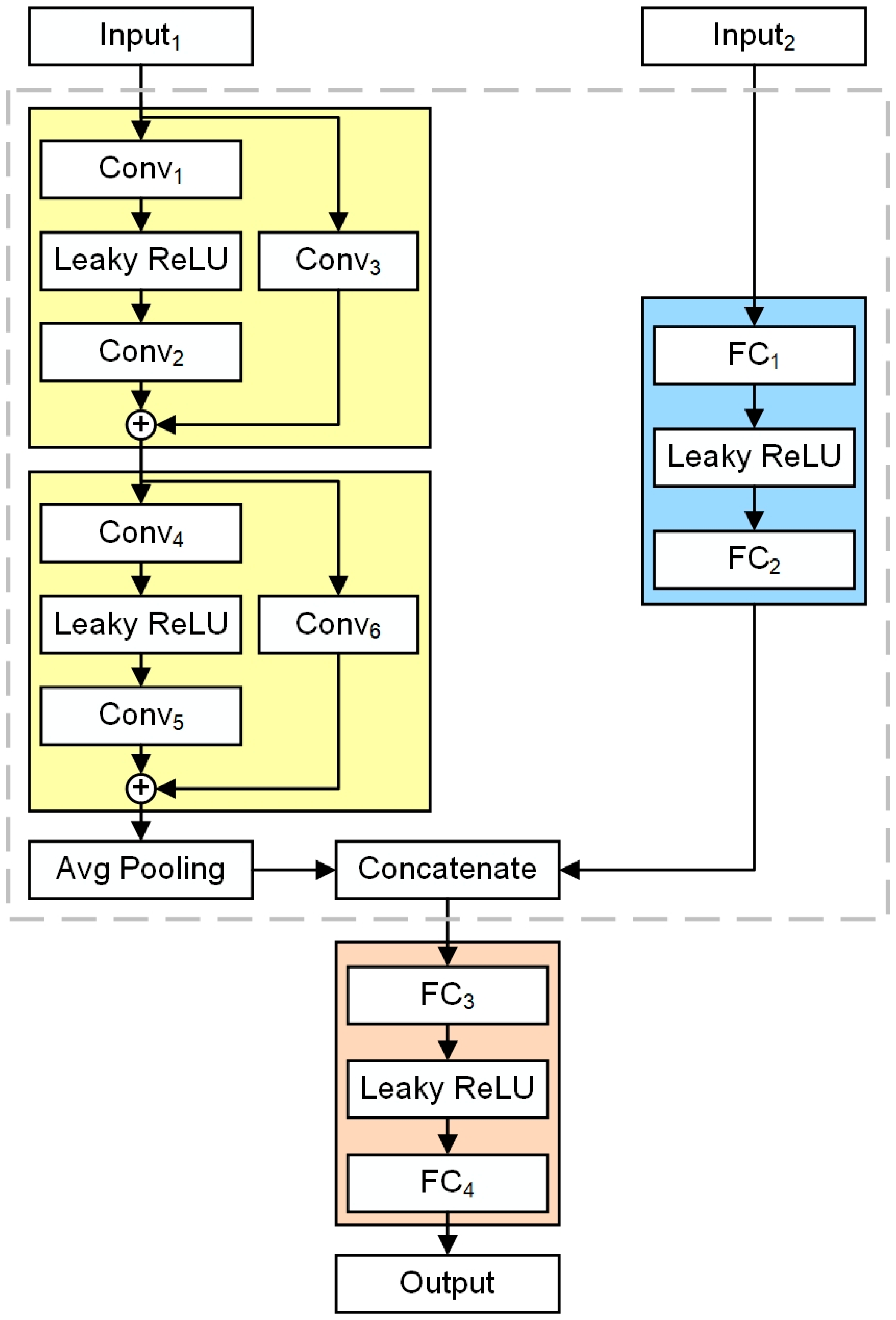
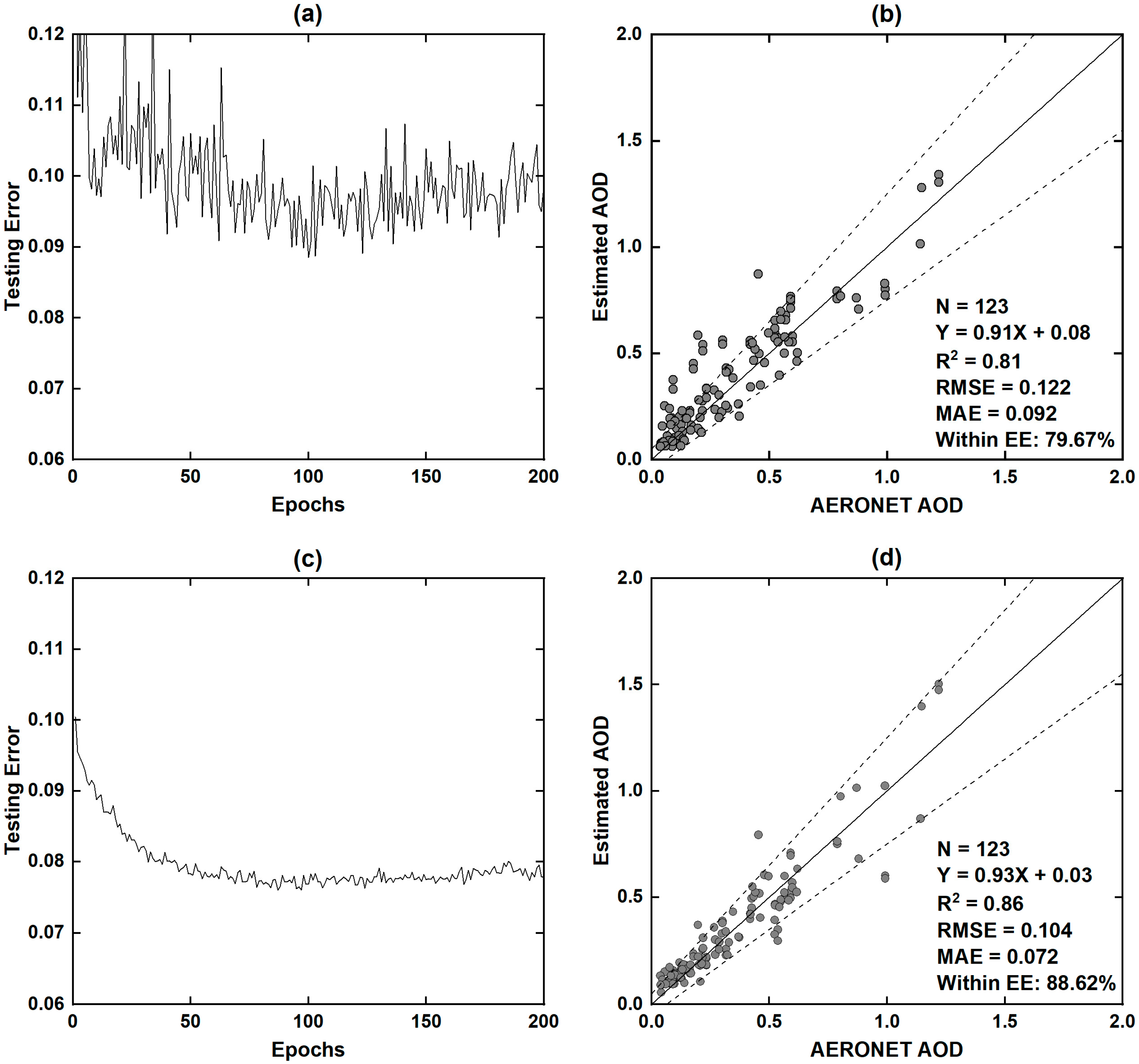
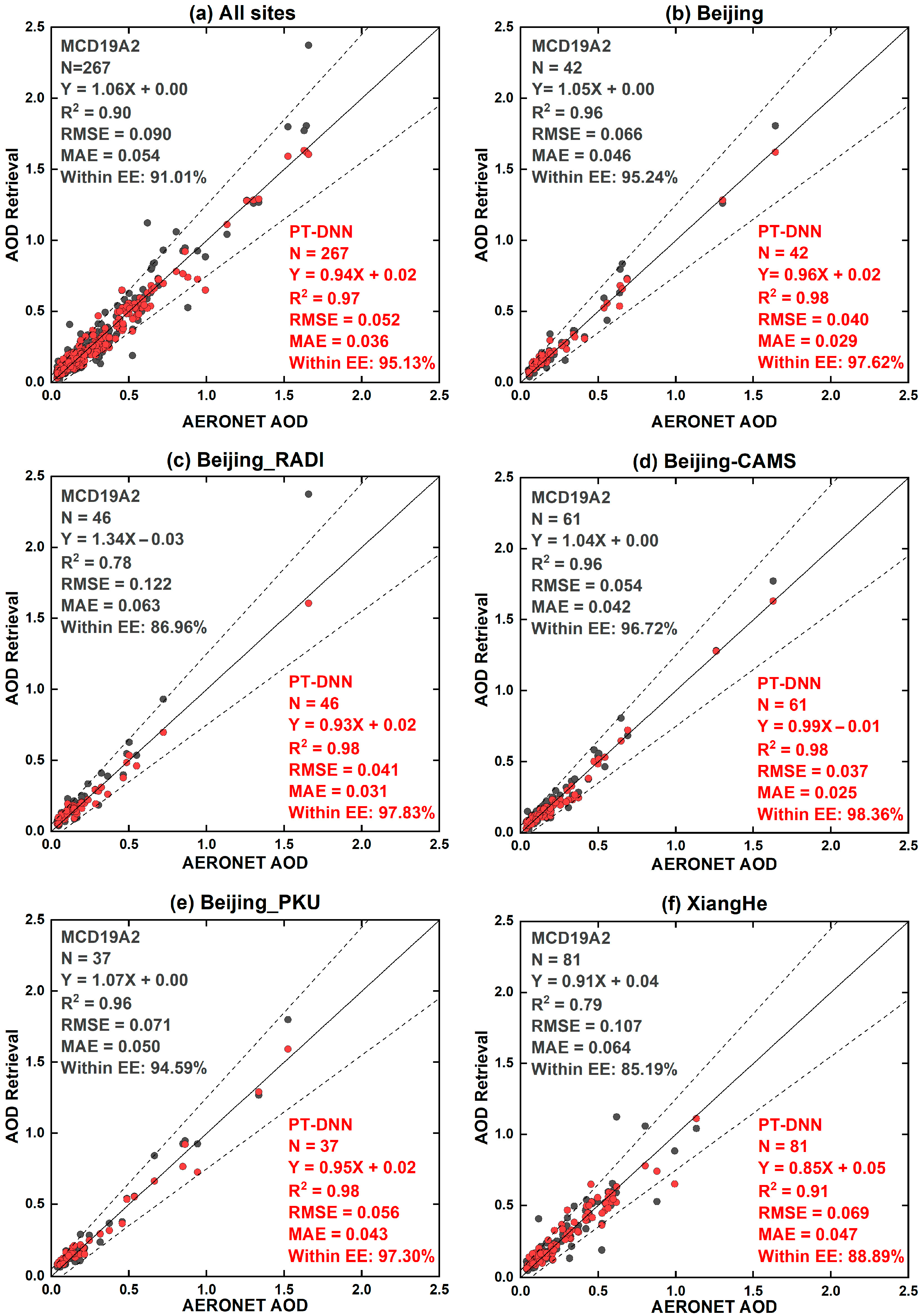
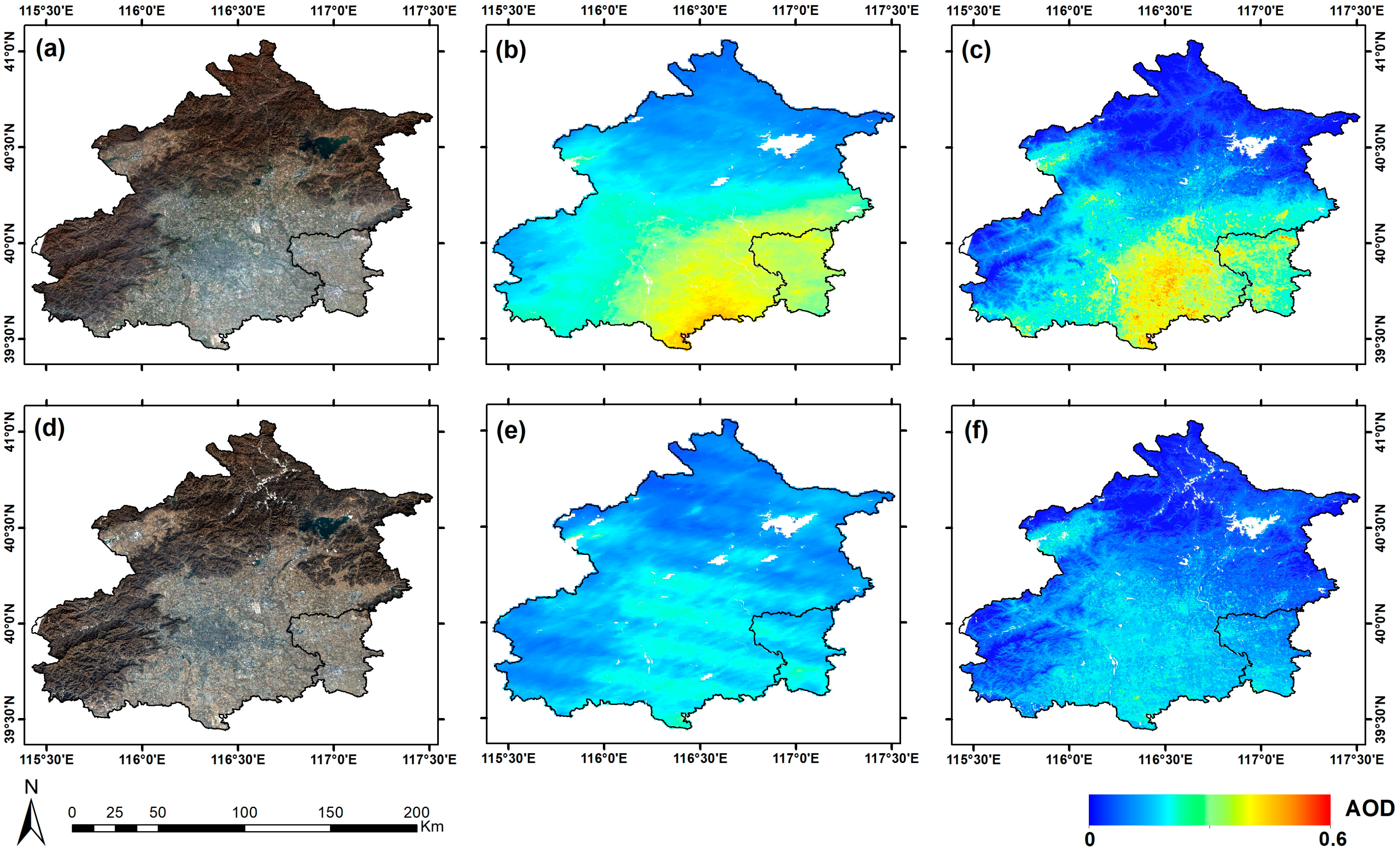

| Variables | Values |
|---|---|
| Atmosphere Model | Midlatitude Summer, Midlatitude Winter |
| Aerosol Model | Continental Model |
| Center Wavelength (nm) | 443, 480, 560, 655, 865, 1610, 2200 |
| SZ (°) | 0, 12, 24, 36, 48, 60, 72 |
| VZ (°) | 0, 1, 2, 3, 4, 5, 6, 7, 8, 9, 10 |
| RA (°) | 0, 12, 24, 36, 48, 60, 72, 84, 96, 108, 120, 132, 144, 156, 168 |
| AOD in LUT 1 | 0.001, 0.01, 0.02, 0.03, 0.04, 0.05, 0.06, 0.07, 0.08, 0.09, 0.1 |
| AOD in LUT 2 | 0.001, 0.1, 0.2, 0.3, 0.4, 0.5, 0.6, 0.7, 0.8, 0.9, 1.0, 1.2, 1.4, 1.6, 1.8, 2.0 |
| Module | Branch | Layer | Parameter | Output Size |
|---|---|---|---|---|
| Feature Extraction | CNN | Conv1 | 10, 64, 3 × 3, 1, 1 | 5 × 5, 64 |
| Conv2 | 64, 64, 3 × 3, 1, 1 | |||
| Conv3 | 10, 64, 1 × 1, 1, 1 | |||
| Conv4 | 64, 128, 3 × 3, 2, 1 | 3 × 3, 128 | ||
| Conv5 | 128, 128, 3 × 3, 1, 1 | |||
| Conv6 | 64, 128, 1 × 1, 2, 1 | |||
| Avg Pooling | 128, 128, 3 × 3, 1, 1 | 128 | ||
| BPNN | FC1 | 8, 16 | 16 | |
| FC2 | 16, 32 | 32 | ||
| Regression | - | Concatenate | - | 160 |
| FC3 | 160, 64 | 64 | ||
| FC4 | 64, 1 | 1 |
| R2 | Beijing | Beijing-CAMS | Beijing_PKU | Beijing_RADI | XiangHe |
|---|---|---|---|---|---|
| Beijing | 1.00 | 0.97 | 0.96 | 0.94 | 0.73 |
| Beijing-CAMS | - | 1.00 | 0.98 | 0.96 | 0.74 |
| Beijing_PKU | - | - | 1.00 | 0.95 | 0.74 |
| Beijing_RADI | - | - | - | 1.00 | 0.72 |
| XiangHe | - | - | - | - | 1.00 |
Disclaimer/Publisher’s Note: The statements, opinions and data contained in all publications are solely those of the individual author(s) and contributor(s) and not of MDPI and/or the editor(s). MDPI and/or the editor(s) disclaim responsibility for any injury to people or property resulting from any ideas, methods, instructions or products referred to in the content. |
© 2025 by the authors. Licensee MDPI, Basel, Switzerland. This article is an open access article distributed under the terms and conditions of the Creative Commons Attribution (CC BY) license (https://creativecommons.org/licenses/by/4.0/).
Share and Cite
Chen, D.; Guo, H.; Gu, X.; Wang, J.; Liu, Y.; Li, Y.; Wu, Y. Physical-Guided Transfer Deep Neural Network for High-Resolution AOD Retrieval. Remote Sens. 2025, 17, 3606. https://doi.org/10.3390/rs17213606
Chen D, Guo H, Gu X, Wang J, Liu Y, Li Y, Wu Y. Physical-Guided Transfer Deep Neural Network for High-Resolution AOD Retrieval. Remote Sensing. 2025; 17(21):3606. https://doi.org/10.3390/rs17213606
Chicago/Turabian StyleChen, Debao, Hong Guo, Xingfa Gu, Jinnian Wang, Yan Liu, Yuecheng Li, and Yifan Wu. 2025. "Physical-Guided Transfer Deep Neural Network for High-Resolution AOD Retrieval" Remote Sensing 17, no. 21: 3606. https://doi.org/10.3390/rs17213606
APA StyleChen, D., Guo, H., Gu, X., Wang, J., Liu, Y., Li, Y., & Wu, Y. (2025). Physical-Guided Transfer Deep Neural Network for High-Resolution AOD Retrieval. Remote Sensing, 17(21), 3606. https://doi.org/10.3390/rs17213606





